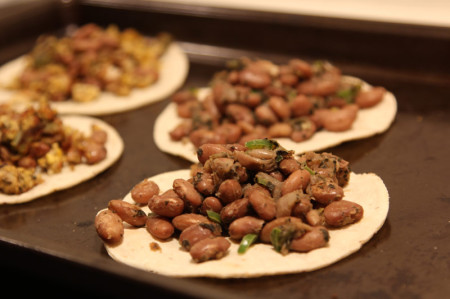
My fiance and I are seasonal workers. Most of our income comes from a winter job that lasts 6 months. It offers health insurance for that time period, so we jump on it each winter. In December I can finally get my cavities filled, and he can upgrade his glasses and contact lenses.
But summer is always harder on us financially. Health insurance costs skyrocket to $350-400 per month (each) if we choose to extend our benefits with COBRA. We work a lot of jobs and barely make ends meet. By the time December rolls around again, we are emptying pockets and jars and every other nook and cranny trying to cover bills while fixing up the old cars and ourselves and getting ready for another season’s work.
I’m not saying this to complain. We chose this life—up high in a winter paradise where well-heeled tourists own second homes and we would be lucky to one day afford a decrepit miner’s cabin because prices are so inflated. We chose to chase our passions and to work outdoors, instead of spending a lifetime of recurring 60-hour weeks in a cubicle—so in that respect, this is very much the good life. But the financial struggle is ever present.
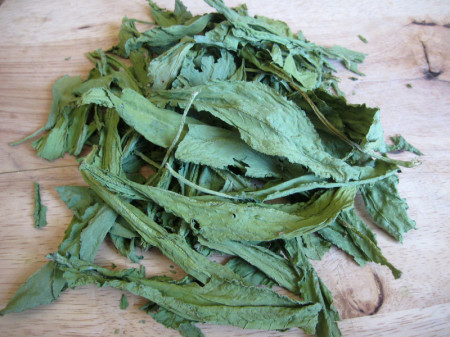
I say this because while I have been busy in the kitchen trying to come up with low-cost, wild-supplemented recipes for my friend Butter’s recipe share—which she devised in the hopes of providing low-cost meal alternatives for those hardest hit by the end of a temporary funding boost from the Supplemental Nutrition Assistance Program (food stamps)—I discovered just how much Gregg and I, too, appreciate being able to fill our own bellies with relatively healthy meals that don’t break the bank.
Dried Dock Leaves
For the wild component, Butter asked me to focus on foods that can be foraged in the Colorado flatlands right now, like dock (Rumex crispus and other dock species) and dandelions (Taraxacum officinale). Since the entire landscape where I live has been covered with snow for weeks, however, I found myself turning to my dried stores.
Dock is often prolific. The common Rumex crispus—which can have quite large leaves with crisped (or curled) margins and produces a tall spire of rust-colored, 3-winged, seed-containing, papery structures called valves—dots fields across the country. The young leaves are edible when they are newly unfurling or so young that they are still rolled up like narrow green scrolls. If they are slimy when you cut or unroll them, they are at their freshest. Here in Colorado, many new leaves emerge in spring, and then again in fall. In fall, they are most easily found growing at the base of the tall, dry, rust-colored stalks.
Like spinach, dock contains oxalates, so if the doctor says not to eat spinach, the same can be considered to apply to dock. The oxalate concentration is higher in mature leaves, which is part of why we go for the young ones. Dock’s flavor is somewhat lemony. Although it is said to be edible raw, I have almost always cooked the leaves and leaf stems—chopped, sauteed, tossed into soups and other dishes, or substituting it anywhere I might want spinach.
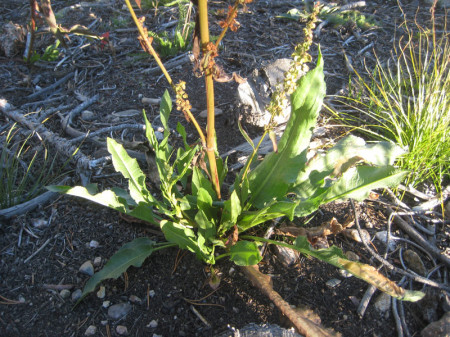
I was collecting leaves of our local docks here at 10,000 feet in the Colorado high country until a couple weeks ago, when the snow decided to stay for good. Earlier this summer, I dried a batch of leaves from one of our local large-leafed docks.
I’ve been drying a lot of greens this year, part of a larger experiment to see how well I like each type of wild green dried and reconstituted. I am pleased to report that the dock’s thick leaves worked well for this purpose. Even the stems, which felt tough in their dry state, reconstituted nicely.
“Greens should not be dried at a high temperature,” commenter Red Moon Frog advises on a forum at Susun Weed’s website. “And they should be stored in labeled glass jars with a tight lid on it. Done correctly they will probably have more nutritional value then the vegetables in the supermarket that have been picked and shipped long distances and then sit on the shelf. Air robs a lot of the nutrients from store-bought veggies. You could add dried wild greens to any simmering pot that has enough water for them to rehydrate, just throwing them into soups and stews is so easy.”
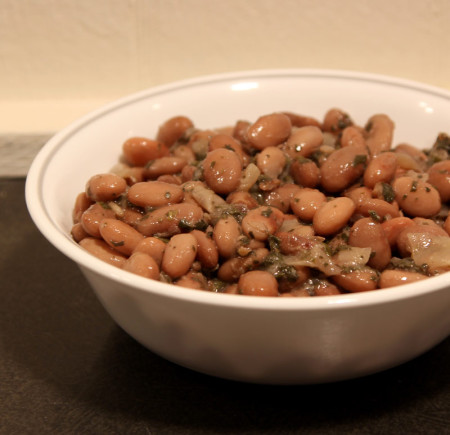
Dried Dock & Beans
Butter asked me to use low-cost proteins and starches like eggs, beans, and potatoes for the rest of the meal. So I made a batch of pinto beans in the crock pot, threw in the crumbled dried dock leaves and stems, and then used that successfully in a couple different dishes. This works well with fresh dock greens too, so I figure you could eat some now and dry some for later, if dock abounds in your surrounds.
Ingredients:
1 bag pinto beans
2 cloves garlic, minced
1 onion, chopped
1.5-2 cups dried dock leaves, crumbled
3 tsp horseradish root, grated
Salt & pepper
Instructions:
To make the dock and beans, I soaked the pinto beans overnight and then threw them in a crock pot for a couple hours with the garlic, horseradish, onion, salt & pepper, and water to cover. Then I added the crumbled dock leaves and let it go a couple more hours, checking to make sure there was always some water in the pot.
Stuff to Do with Beans & Dried Dock
The recipe is pretty basic and could surely be improved upon, but one thing’s for certain—anyone could do it, as you could use a pot on the stovetop in place of a crock pot. I included horseradish because Butter’s neighbor was so kind as to let us dig some up from her yard, and it is a sometimes prolific volunteer.
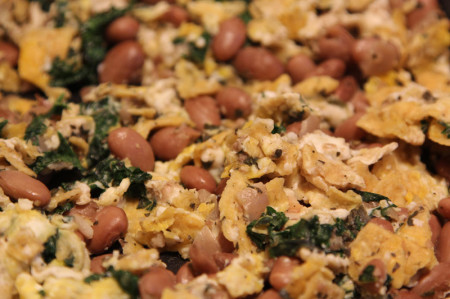
We’ve stretched the crock pot beans into five meals so far. First, I ate a lunch bowl of dock and beans in their juices with rolled-up corn tortillas for dipping. My friend in Los Angeles prides himself on his frijoles and likes to eat the first bowl this way. At night we had them rolled into tortillas with lettuce and cheese, and in the mornings I made soft tacos with pan-fried corn tortillas, eggs, dock and beans, and sautéed green peppers (the first day) and onions (the second day). We also had a tostada dinner, which consisted of two different dock-and-pinto-bean mixes—leftover eggs from the morning on one, and dock and beans spiced up with sauteed jalapenos on the other—served on hard, flat tostadas made by broiling the tortillas. All meals were well-received, despite so many bean dishes served back-to-back.
My estimation skills are pretty horrid but the bag of beans was like $1.50; the tortillas $1.50, the onions, garlic, and jalapeno less than $1 combined, and another $.50 for the green pepper. Add in any other required kitchen ingredients like oil, lettuce and cheese, and we’ll say there was a total expenditure of $5 give or take. Five meals for two people comes to $.50 per meal. That’s not bad, and it could probably be better.
After that we took a break from the beans, though there’s still some left in the fridge. I keep having visions of a cornbread and dock and pinto bean pie of some sort, so maybe I’ll try to figure out how to make that next.
EDIT 11.7.13: The quote about drying greens was incorrectly attributed to Susun Weed in the original post. The quote was by commenter Suzanne, who goes by Red Moon Frog, not Susun. The change is reflected above.

Leave a Reply